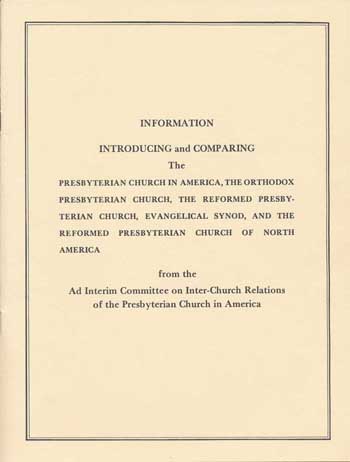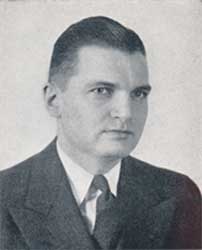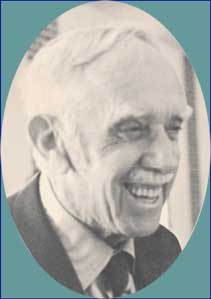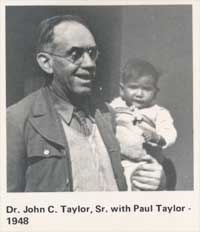He Was Always Preparing
In 1982, the denomination known as the Reformed Presbyterian Church, Evangelical Synod (RPCES) was received into Presbyterian Church in America (PCA). This ecclesiastical merger was known as the Joining and Receiving (J&R). The RPCES was itself created by the union of two denominations, in 1965. One denomination had a shorter history. This was the Evangelical Presbyterian Church (EPC), as it was known from 1961-1965. Prior to that, it operated under the name of the Bible Presbyterian Church, Columbus Synod, and this group was the larger portion of a split of the Bible Presbyterian Church [1938-1955].
The other denomination that merged with the EPC to create the RPCES was the Reformed Presbyterian Church, General Synod (RPCGS), and this group had a much longer history, dating back to 1833. That was the year in which the Reformed Presbyterian Church suffered a split, thus creating the RPCGS. The other body created by this split is in existence to this day—the Reformed Presbyterian Church of North America (RPCNA).
Are you thoroughly confused yet? To recap, the PCA received the RPCES in 1982, and the RPCGS was one of the two denominations that united to form the RPCES. (see! that wasn’t so tough!).
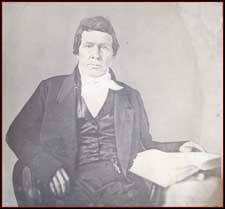 Which brings us to the Rev. John Black, who served as the first Stated Clerk of the Reformed Presbyterian Church, General Synod. And as the combined history of the denomination received in 1982 became part of the history of the PCA, it was in that sense, in a manner of speaking, that we might call Dr. Black the first Stated Clerk of the PCA.
Which brings us to the Rev. John Black, who served as the first Stated Clerk of the Reformed Presbyterian Church, General Synod. And as the combined history of the denomination received in 1982 became part of the history of the PCA, it was in that sense, in a manner of speaking, that we might call Dr. Black the first Stated Clerk of the PCA.
John Black had been born in Northern Ireland, in the county of Antrim, on October 2, 1768, and it was only after reaching adulthood that he immigrated to this country. He had been educated at Glasgow College, in Scotland and left for America in 1797. For a while he worked as a teacher, but soon was licensed to preach by the Reformed Presbyterian Church, in 1799. Upon his ordination, Rev. Black settled in the region of Pittsburgh, which was then just a small village, and there he remained the pastor of the same church for forty-eight years, until the close of his life, on October 25, 1849.
As a preacher, he was “distinct, plain, a fluent speaker, always interesting and often eloquent and powerful.” And time and again he proved himself as one who was always ready to preach, whenever called. Yet he never wrote out or memorized his sermons. “He was ready, because he had a full mental storehouse,—the power of abstraction, the gift of language, a great command of the resources of his own mind, and, above all, a strong, humble and unwavering dependence on the help of God’s Holy Spirit. He preached because he loved the work, and had found, by repeated trial, that he had from God the ready power to perform it. And, yet, Dr. Black prepared to preach. He was always preparing. His studies were never finished, and, to the close of his life, he was a laborious student. His views of the Christian ministry were too high to admit of the attempt to serve God with what had cost him nothing. He selected his subject, elaborated it in his mind, used all available helps, wrote upon paper an extended skeleton, and so went to the desk to speak on God’s behalf to sinners. He preached for nearly fifty years, and then died with the harness on.”
To give a flavor of his sermons, here is an excerpt from a sermon which he delivered at the opening of the Synod of the Reformed Presbyterian Church as it met in Philadelphia in May of 1816. The sermon is on the subject of “Church Fellowship;” Rev. Black begins:—
Saints by profession, are bound to hold communion and fellowship, in the worship and service of God.
I. I am to explain this Communion—
1. It is a communion of Saints. The house of God is holy, and holiness becometh it well forever. Here the social principle is exercised in its perfection on earth. It is devoted to holy purposes, and consecrated to the Lord of the whole earth. None have a right, in the sight of God, to this holy fellowship, but real Saints, and none but such really enjoy it. Others, though they may be present, and appear to participate in the communion of the Saints. yet it is only in appearance. Externally, they draw near to God in his holy institutions,. but their hearts have no concern in the solemnity. The character of such is given in Ezekiel, 33:31. “And they come unto thee as the people cometh, and they sit before thee as my people, and they hear thy words, but they will not do them: for with their month they shew much love, but their heart goeth after their covetousness.” But those who are Saints, were once, a very different character. They were, by nature, children of wrath, even as others. How then do they obtain this character? No way but by union to Jesus Christ, through the regenerating influence of the Spirit of God. Means are generally used, but the efficiency is of God. In the day of effectual working of his Holy Spirit, lays on them an arrest of mercy. They are apprehended by Christ, and are made to apprehend him. Their understandings are enlightened, so that they are enabled to discover the certainty, the value, the excellency, the suitableness of Jesus the Saviour, to their needy case. Objective testimony is furnished, with such undoubted evidence, that they become convinced, and are verily persuaded, not only that they may fully and freely accept of the offered salvation, but that it is the best and the most desirable thing so to do. The will, renewed by the Holy Ghost, follows the dictate of the understanding, and actually receives the Lord Jesus Christ, appropriating him for life and salvation. This completes a mystical and indissoluble union between Christ and the believer’s soul. Christ, by the bond of his spirit, unites himself to the elect sinner, in regeneration, and the sinner, effectually called, by the bond of faith unites himself to the person of the Redeemer. The believer, thus united to Christ, is in the court of heaven, sustained, as righteous. Christ and he being one, whatever is Christ’s is reckoned to the believer. Christ’s righteousness is his, and on account of that righteousness, he is justified. His name is changed from sinner to saint.
We have said, that only such as are thus really Saints, are, in the sight of God, entitled to the communion and fellowship of his church. But as the heart of man is known only to God—as it is his prerogative, and only his, to search the heart and try the reins, an absolute knowledge of this union to Christ, which constitutes men really Saints, cannot belong to this communion. Only Saints by profession, such as possess those distinctive characters which the head of the church has laid down in his word, by which we may, in the judgment of charity, know, and esteem men to be his followers. By their works shall ye know them. If they are sound in the faith, and have a life and conversation, such as becometh the gospel; they are to be reputed Saints, and with such, we are bound to have communion.
2. It is a communion of love and holy affections.
Not only are all Saints united to the Head Christ Jesus, but they are all united to one another in love. They are members one of another. They have one common interest, and they mutually seek each other’s good. They are all actuated by the same spirit. They are all concerned for the honour of their glorious head. They are brethren, children of the same Father and of the same Mother. God is their Father. By him they were spiritually begotten, through the instrumentality of the word of truth. The Church is their Mother. By her they were brought forth. The spouse (the individual believer) calls the church her mother’s house, the chambers of her that conceived her. There are, it is true, some mother’s children, that are not the Father’s children, nominal professors, who love not the real children of the family: but all who are the children of adoption, the sons and the daughters of the Lord Almighty—have a communion in one another’s love. They seek the good of the family, and they live together in unity, as it becometh brethren. This love, and kind affection, is opposed to the biting and devouring of one another. It is opposed to quarrels and intestine broils, the disgrace and the ruin of every family. It is opposed to schism and divisions. Those who possess this principle of love, will cover with the mantle of charity the failings and the infirmities of their brethren. They will bear one another’s burdens. They will be gentle and easy to be entreated. They will not willingly give, or take, offence. But bound up in the bundle of life and of love, with the rest of the members of the household of faith, they will take sweet counsel together, and walk to the house of God in company….”

